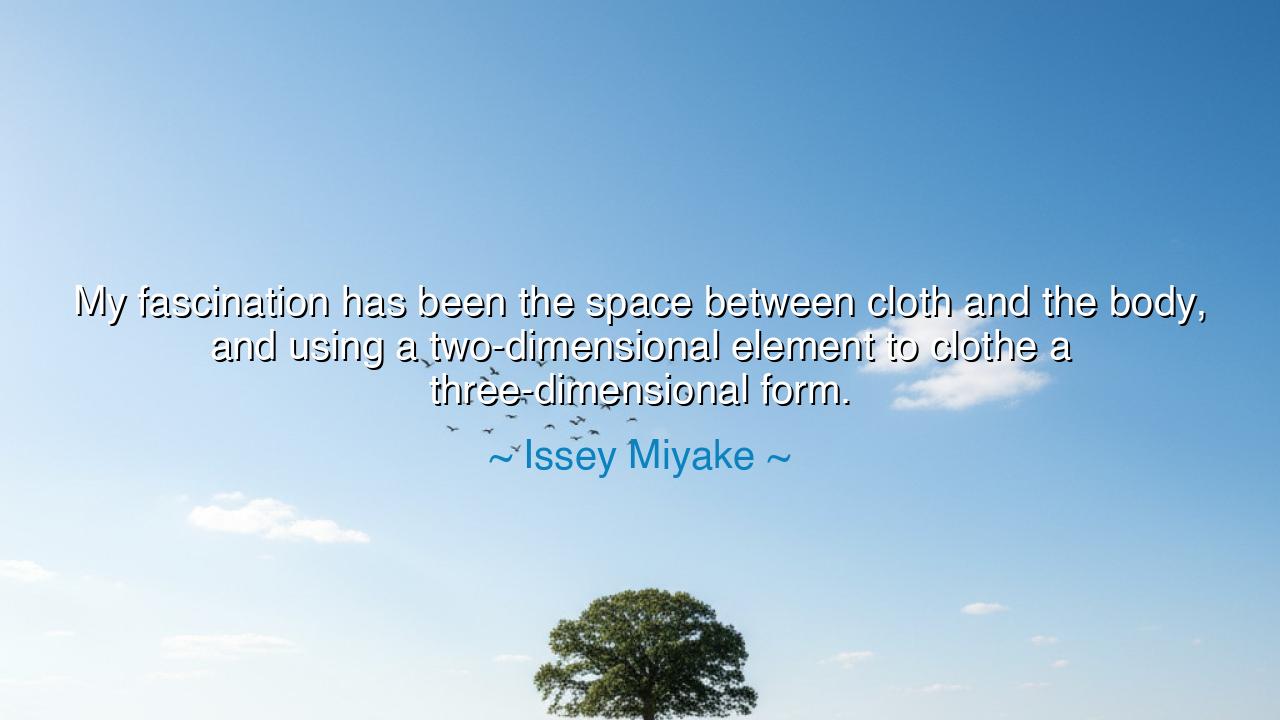
My fascination has been the space between cloth and the body, and
My fascination has been the space between cloth and the body, and using a two-dimensional element to clothe a three-dimensional form.






Issey Miyake, master of fabric and form, once revealed the heart of his vision with these words: “My fascination has been the space between cloth and the body, and using a two-dimensional element to clothe a three-dimensional form.” These words, though simple in sound, carry the depth of an artist who did not see clothing merely as covering, but as dialogue. For he understood that fashion is not only about the garment itself, but about the invisible space where fabric and flesh meet, where movement, breath, and life transform the still into the living.
To speak of the space between cloth and body is to speak of possibility. The cloth, flat and without shape, is nothing but potential—an empty canvas. The body, full of curves, energy, and motion, is a living sculpture. Between them exists a sacred tension: the garment does not simply wrap the body, but interacts with it, echoing its lines, resisting or flowing with its movement. Miyake, in contemplating this union, saw clothing as an art of transformation, where the two-dimensional is elevated into the three-dimensional by the presence of life.
The ancients knew this truth, though in different terms. The Greeks carved statues with robes clinging and flowing, understanding that fabric reveals even as it conceals, shaping how the body is perceived. In Japan, the kimono was not merely cloth but architecture—a flat expanse folded and wrapped into harmony with the form. Miyake, heir to both traditions, brought this ancient wisdom into the modern world, seeking to bridge simplicity and complexity, flatness and depth.
Consider his Pleats Please collection, where cloth was pressed with permanent folds that responded to movement. At rest, the garment appeared simple, almost plain. But when the wearer walked, danced, or turned, the fabric unfolded like rippling water, expanding into new shapes. Here the truth of his words is revealed: the garment is not complete until the body animates it, and the true art lies in the space between. In this way, Miyake’s creations were not static objects, but living companions to human life.
There is also a deeper meaning beyond fashion. His quote reminds us that life itself is the art of bridging dimensions. We take flat ideas and give them shape in the world. We take two-dimensional dreams and make them three-dimensional realities. Just as cloth without a body is lifeless, so too are visions without action, or words without embodiment. The lesson of Miyake’s art is that form is born not in isolation but in interaction.
Therefore, O listener, let this teaching guide you: honor the spaces in your life—the places between thought and deed, between self and others, between stillness and movement. For it is in these in-between spaces that creation unfolds. Do not despise the two-dimensional beginnings of your work, no matter how flat or simple they seem. When joined with the body of your effort, they will rise into depth and fullness.
Practical action follows: when you create—whether in art, in relationships, or in your own self—attend to the spaces. When you speak, leave room for silence; when you build, leave room for breath; when you design your life, allow the fabric of your days to move with the body of your soul. Remember that beauty is not only in the finished form, but in the dialogue between stillness and motion, between flat cloth and living body.
So let Miyake’s words endure as wisdom: “My fascination has been the space between cloth and the body…” For in that space lies all creation, all transformation, all possibility. Life itself is the art of turning the flat into the full, the imagined into the lived. And just as cloth awakens upon the body, so too do our visions awaken when they are given the chance to move, breathe, and live in the world.






AAdministratorAdministrator
Welcome, honored guests. Please leave a comment, we will respond soon